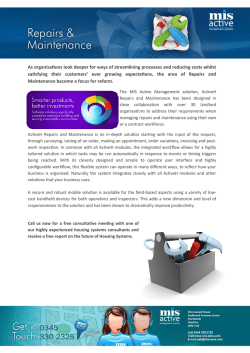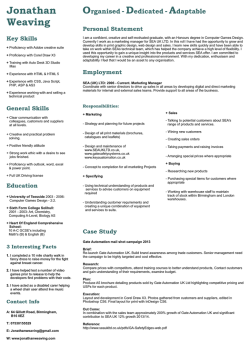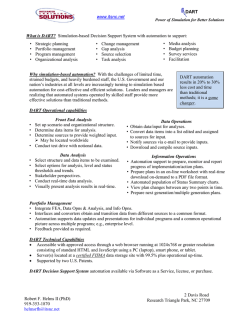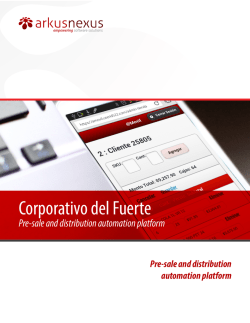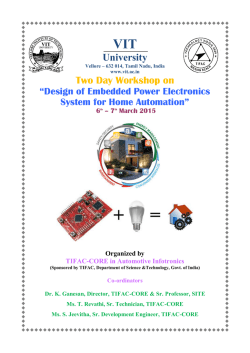
Towards Automated Service Composition using Policy Ontology in
Towards Automated Service Composition using Policy Ontology in
Building Automation System
Son N. Han, Gyu Myoung Lee, Noel Crespi
Department of Wireless Networks and Multimedia Services
Institut Mines-Telecom, Telecom SudParis
91011 Evry Cedex, France
{son.han, gm.lee, noel.crespi}@it-sudparis.eu
Abstract—Automated service composition is critical for successfully implementing Building Automation Systems which
facilitate Web services over physical devices. In this paper,
we propose a new service composition model using a policy
ontology represented by Semantic Web languages. Our proposed model can be a powerful tool to automatically compose
services with associating meaningful policies.
Keywords-service composition; semantic web; policy; ontology; building automation system;
I. I NTRODUCTION
In building automation industry, there are several communication protocols and a variety of products from various
vendors available on the market. It is a challenge for
coordinating heterogeneous devices or appliances, in which,
topologies, communication protocols, security policies, and
such are dynamic and different from one to another. An
approach from the Internet of Things (IoT) paradigm is
to make physical devices accessible as Web services that
are identified by Uniform Resource Identifiers [1]. Many
innovative architectures for automation systems based on the
concept of Web services and Service-Oriented Computing
have been proposed [2]. In order to successfully deploy Web
services for automatic control systems like Building Automation System (BAS), we need an automatic mechanism
to combine separate services into a composite one to meet
the diversity of user’s requirements. This can be achieved
by a process called automated Web service composition.
Semantic Web [3] visions the possibility of semantically understanding between services. So that practical and powerful
applications can be written by using semantic annotations
and suitable inference engines to automatically compose
Web services.
So far, there have been several efforts to use semantics
for BAS by designing ontologies [4], [5]. However, these
approaches aim at different frameworks of BAS rather than
Web service-based. In [4], a comprehensive ontology on the
domain of BAS was proposed. However, BAS ontology with
knowledge and terms for describing BASs makes a little
impact on the process of service composition that is usually
governed by composition rules.
In this paper, we propose a model for automated service
composition using a policy ontology that is represented
by Semantic Web languages. Policies are means to dynamically regulate the behavior of system components. By
changing policies, a system can be continuously adjusted to
accommodate variations in externally imposed constraints
and environment conditions. The adoption of a policy-based
approach for controlling a system requires an appropriate
policy representation. In our approach, we aim at representing policies semantically by Semantic Web languages,
putting them all together in a Building Automation Policy
Ontology (BAPO). In the following sections, after outlining
the BAPO-based service composition model, we present a
design of BAPO and an algorithm for Workflow Generation.
II. BAPO- BASED S ERVICE C OMPOSITION M ODEL
Figure 1 shows the main components of BAPO-based
service composition model. User gives input requirements
semantically into User Requirements unit and the system
automatically generates an output composite service and
then store it back in the Services Repository. BAPO is
written in Web Ontology Language (OWL) [6] to describe
policy concepts and relationships between them, which are
represented in classes and properties respectively. BAPO
covers all necessary types of policies and is updated constantly. Workflow Designer consists of two parts: Workflow
Generator is for automatically generating service workflow
with reference to Workflow Templates database and Workflow Editor is to assist users for designing workflow or
Figure 1.
BAPO-based Service Composition Model
correcting workflow generated from Workflow Generator.
The workflow created in Workflow Designer is stored in
Workflow Templates database for future use. Service Selection Engine is the implementation of selection algorithms
to automatically select an appropriate service among available ones from Services Repository. In Services Repository,
services are described by Semantic Annotations for WSDL
(SAWSDL) [7]. SAWSDL provides semantic descriptions
of policies of Web services in service profiles. The profiles
are therefore used for advertising registry, discovery, and
matchmaking for the Service Selection Engine to find the
service that meets required policies.
III. BAPO D ESIGN AND W ORKFLOW G ENERATION
A LGORITHM
A. A BAPO Design
BAPO consists of information about classes and properties in the domain of building automation policies. Classes
describe concepts of policy and properties of each class
describing various features and attributes of the concept. For
example, in Figure 2 class UserPreferencePolicy has five
subclasses with is-a relationship. That means all properties
from UserPreferencePolicy are included in subclasses. We
designed BAPO version 1.0 by Protege ontology editor
software [8]. Figure 2 partly shows the class hierarchy of
BAPO with some of its classes without their properties. All
classes are derived from the root OWL class owl : T hing.
B. A Workflow Generation Algorithm
We made an algorithm for automatic generation of a
workflow following user’s requirements. User can use a
Web-based application to give semantic requirements that
are instances of BAPO classes. By representing policies
in BAPO, the following algorithm can easily generate the
desired workflow.
Definition: Semantic Requirement
A semantic requirement is an instance of a class in BAPO
Figure 2.
BAPO 1.0 Class Hierarchy
Algorithm: Workflow Generation
Input: User Uk semantic requirements {sr1 , sr2 , ..., srn }
Output: Service workflow {s1 , s2 , ..., sn }
Given user BAPO and Services Repository
BEGIN
Denote {C1 , C2 , ..., Cn } are concept classes of semantic
requirements
For each Ci find a list of services {sij } that satisfy Ci and
user Uk AuthenticationPolicy
Repeat
- Pick one in each list sij to form a set
- Match them with ServiceLocationPolicy
- Continue if there is ServiceLocationPolicy conflict
Until exist one perfect match.
END.
For example, one employee working in an office at the
building want to remotely turn on heater and light in his
office 10 minutes before his arrival. He can have access to
the Web-based application and semantically ask for such
composite service.
IV. C ONCLUSION AND F UTURE R ESEARCH
We have proposed a preliminary model for automated
service composition in BAS. We have already built the
first version of BAPO and implemented an algorithm for
workflow generation. We still have a substantial workload to
fulfil including continuously updating the BAPO, designing
related algorithms for Service Selection Engine, developing
a prototype system as well as the Web-based application
with a graphical user interface.
R EFERENCES
[1] A. Kamilaris, V. Trifa, and A. Pitsillides, “Homeweb: An application framework for web-based smart homes,” in Telecommunications (ICT), 2011 18th International Conference on, may
2011, pp. 134 –139.
[2] F. Jammes and H. Smit, “Service-oriented paradigms in industrial automation,” Industrial Informatics, IEEE Transactions
on, vol. 1, no. 1, pp. 62 – 70, feb. 2005.
[3] T. Berners-Lee, J. Hendler, and O. Lassila, “The semantic
web,” Scientific American, pp. 29–37, May 2001.
[4] C. Reinisch, W. Granzer, F. Praus, and W. Kastner, “Integration of heterogeneous building automation systems using
ontologies,” in Industrial Electronics, 2008. IECON 2008. 34th
Annual Conference of IEEE, nov. 2008, pp. 2736 –2741.
[5] S. Runde, H. Dibowski, A. Fay, and K. Kabitzsch, “A semantic
requirement ontology for the engineering of building automation systems by means of owl,” in Emerging Technologies
Factory Automation, 2009. ETFA 2009. IEEE Conference on,
sept. 2009, pp. 1 –8.
[6] “Web
ontology
language.”
[Online].
Available:
http://www.w3.org/2004/OWL/
[7] “Semantic annotations for wsdl and xml schema.” [Online].
Available: http://www.w3.org/2002/ws/sawsdl/spec/
[8] “Protege.” [Online]. Available: http://protege.stanford.edu
© Copyright 2026
